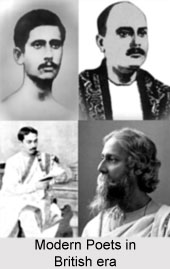 Bengali poetry in the early twentieth century did not see the production of many important works. One of the major writers who started off from the journal Bharati was Satyendranath Datta (1882-1922). Datta`s work presents a foil to the kind of poetry Rabindranath Tagore was producing at this time. Datta was more interested in experimenting with versification and prosody. Starting with Benu O Bind (The Flute and the Lute) in 1906, where the influence of predecessors is clear, he produced more mature work in Phuler Phasal (The Crop of Flowers, 1911) and Abhra Abir (Mica and Vermilion Dust, 1916). The latter work is characterized by brave metrical experiments, never seen before in Bengali poetry. Datta`s metrical accomplishments opened up the formal possibilities of Bengali poetry, and he is fondly remembered as its "Metrical Wizard."
Bengali poetry in the early twentieth century did not see the production of many important works. One of the major writers who started off from the journal Bharati was Satyendranath Datta (1882-1922). Datta`s work presents a foil to the kind of poetry Rabindranath Tagore was producing at this time. Datta was more interested in experimenting with versification and prosody. Starting with Benu O Bind (The Flute and the Lute) in 1906, where the influence of predecessors is clear, he produced more mature work in Phuler Phasal (The Crop of Flowers, 1911) and Abhra Abir (Mica and Vermilion Dust, 1916). The latter work is characterized by brave metrical experiments, never seen before in Bengali poetry. Datta`s metrical accomplishments opened up the formal possibilities of Bengali poetry, and he is fondly remembered as its "Metrical Wizard."
In general, the turn of the century was not a very productive time for Bengali poets. But among the few who wrote good poetry was Priyambada Deb (1871-1935), whose work stands out prominently. It is felt by many that her poems are extremely well-crafted, with a tone which is tender, subdued and quiet. Writing mainly for the revived Bangadarsan a late nineteenth-century literary journal, she also published collections of her poems, namely, Renu (1900), Patralekha (1910), and Amu (1927). Two other poets who have contributed in the field of Bengali poetry, and who have been the followers of Tagore are Rajanikanta Sen (1865-1919) and Atulprasad Sen (1871-1938). However, since they were both primarily songwriters, as opposed to poets, it is predominantly in the shape of songs that their creations have endured in Bengali culture. Their songs continue to be performed and recorded by leading Bengali vocalists for commercial consumption.
This article is a stub. You can enrich by adding more information to it. Send your Write Up to content@indianetzone.com



















